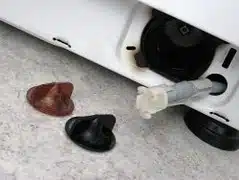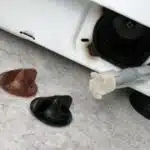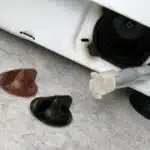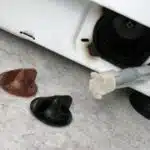As a home appliance technician, one of the most common issues I come across is mold growth in washing machines. Mold can accumulate within the drum, dispenser drawer, and rubber gasket of a washing machine, leading to unpleasant odors and even health hazards if left untreated. If you notice any signs of mold in your washing machine, it is crucial to take immediate action to efficiently clean it.
Cleaning mold out of a washing machine may seem like an overwhelming task, but with the right approach and tools, you can easily eliminate the problem. In this article, I will provide you with comprehensive steps on how to clean mold out of your washing machine. Not only will this process eliminate any unpleasant odors caused by mold growth, but it will also ensure that your clothes are being washed in a safe and hygienic environment. So let’s dive in!
Signs Of Mold Growth In A Washing Machine
Mold growth in a washing machine is a common problem that can lead to unpleasant odors and potentially harmful health risks. Identifying mold spores in your washing machine may not be easy, but there are certain telltale signs of their presence. One of the most obvious signs of mold growth is the presence of black or green spots on the rubber seal or gasket around the door of the washing machine. Additionally, if you notice an unusual musty smell coming from your washing machine even after it has been washed, this could also indicate mold growth.
Preventive measures for mold growth can go a long way in avoiding future problems with your washing machine. It is important to keep your washing machine clean and dry when not in use by leaving the door open or using a fan to circulate air. Never leave wet clothes sitting in the washer for extended periods of time as this can create an ideal environment for mold to grow. If possible, try to use hot water and bleach when doing laundry as this can kill any existing mold spores.
Understanding the health risks associated with mold growth in a washing machine is crucial in preventing potential harm to you and your family. Exposure to mold spores can cause respiratory problems, allergic reactions, and other health issues. Therefore, it is important to take action immediately upon detecting any signs of mold growth in your washing machine.
Understanding The Health Risks Of Mold In A Washing Machine
Understanding the health risks of mold in a washing machine is crucial for everyone who uses this appliance to clean their clothes. Mold growth can cause respiratory problems, allergies, and infections that can be dangerous to people with weakened immune systems. Additionally, mold spores can spread throughout the house and affect other parts of the home. Therefore, it’s essential to identify the causes of mold growth in a washing machine and take appropriate measures to prevent it.
Identifying the causes of mold growth in a washing machine is relatively easy. One of the most common reasons is leaving wet clothes inside the washer for an extended period. This creates a humid environment that encourages mold to grow rapidly. Another cause is using too much detergent or fabric softeners, which leave residue that promotes mold growth. Finally, using cold water instead of hot water can also contribute to mold growth as it doesn’t kill bacteria and fungi.
To prevent mold growth in a washing machine, follow these simple steps:
- Leave the door open after every wash cycle to allow air circulation.
- Use only recommended amounts of detergent and fabric softeners.
- Clean the dispenser drawer frequently.
- Run a maintenance wash regularly using hot water and bleach.
By following these preventive measures, you reduce your chances of having mold grow inside your washing machine. However, if you already have a mold problem, you’ll need to take safety precautions before cleaning it out from your washer.
Safety Precautions Before Cleaning Mold Out Of A Washing Machine
As a home appliance technician, one of the most important things to keep in mind before cleaning mold out of your washing machine is safety. This means taking necessary precautions to avoid any potential harm that may come from exposure to harmful chemicals or mold spores. To begin with, it is important to wear gloves when handling any cleaning detergent or bleach. This will help protect your skin from direct contact with these harsh chemicals.
In addition, proper ventilation is also critical when dealing with mold infestations in washing machines. It is recommended that you open all windows and doors in the room where the washing machine is located before starting the cleaning process. This will ensure that fresh air flows through the space and helps reduce the concentration of mold spores in the air.
By following these safety guidelines, you can significantly minimize any health risks associated with cleaning mold out of your washing machine. Wearing gloves and ensuring proper ventilation are simple yet effective measures you can take to protect yourself and others around you. With these precautions taken care of, you can now move on to gathering all necessary materials for cleaning mold out of your washing machine.
Gathering The Necessary Materials For Cleaning Mold Out Of A Washing Machine
Prior to cleaning a washing machine for mold, it is important to assemble the necessary materials. This consists of protective gloves, a face mask for respiratory protection, household bleach, a sponge or cloth, and a bucket. The next step is to identify the presence of mold, which is typically visible as a slimy, discolored growth on the interior of the machine. It is advisable to consult the manufacturer’s manual to ensure that the cleaning process is performed safely and effectively.
Gathering Supplies
To effectively clean mold out of a washing machine, it’s important to gather the necessary cleaning supplies beforehand. Homeowners can purchase these cleaning supplies from various stores such as home improvement centers, hardware stores, and online retailers. However, it’s essential to ensure that the products selected are safe for use on washing machines and won’t cause any damage or corrosion over time.
For those who prefer DIY alternatives for cleaning supplies, several options are available. White vinegar is an effective natural remedy for mold removal and can be found in most grocery stores. Baking soda is another alternative that can be used to clean mold off of the washing machine drum. Additionally, essential oils like tea tree oil or grapefruit seed extract mixed with water can also be useful in eliminating mold growth.
When gathering supplies for cleaning mold out of a washing machine, homeowners should prioritize safety and effectiveness. It’s important to read labels carefully and select products that are specifically designed for use on washing machines. For those who prefer natural remedies, there are several DIY alternatives available that can be just as effective when used properly. By taking the necessary precautions and selecting the right materials, homeowners can effectively remove mold from their washing machines without causing any additional damage or harm.
Identifying Mold
When gathering the necessary materials for cleaning mold out of a washing machine, it’s crucial to first identify the presence of mold. Mold is a common problem that can occur in washing machines, and it’s important to know how to recognize it. There are several types of mold that can grow inside a washing machine, including black mold, green mold, and white mold. Inspecting the interior of the washing machine drum, gasket seal, and detergent dispenser tray can help homeowners determine whether or not there is a mold problem.
Preventing mold growth in washing machines is also an essential practice. Best practices for preventing mold include leaving the washing machine door open after use to allow air circulation and regularly wiping down the interior surfaces with a damp cloth. Additionally, using natural remedies like white vinegar or baking soda instead of harsh chemical cleaners can also help prevent the growth of mold.
In conclusion, identifying mold in a washing machine is an important step before gathering supplies for cleaning. Homeowners should inspect their machines regularly and take preventative measures to avoid future growth. Using natural remedies like vinegar or baking soda can also be effective in preventing the growth of mold in addition to properly cleaning it out when needed.
Removing The Dispenser Drawer For Cleaning
To effectively clean mold out of your washing machine, it is important to remove the dispenser drawer for a deep cleaning. The dispenser drawer can accumulate soap scum and other debris over time, which can contribute to the growth of mold. It is recommended that you clean the dispenser drawer at least once every three months.
To remove the dispenser drawer, begin by pulling it out as far as it will go. Next, press down on the release button located on the back of the drawer. This will allow you to fully remove the drawer from the washing machine. Once removed, take a closer look at the dispenser drawer and check for any signs of mold growth.
To deep clean the dispenser drawer, use warm water and a mild detergent. Scrub all surfaces thoroughly with a soft-bristled brush until all soap scum and debris have been removed. Rinse with clean water and dry with a soft cloth before replacing the dispenser drawer back into its original position. By following these steps, you can ensure that your washing machine’s dispenser drawer is fully cleaned and free from mold growth.
Transition: Now that you have successfully removed and deep cleaned your washing machine’s dispenser drawer, it’s time to move onto cleaning another important component – the rubber gasket.
Cleaning The Rubber Gasket Of A Washing Machine
During the cleaning process, it is important to understand that mold growth is a common problem in washing machines. Mold thrives in moist environments, and the rubber gasket around the door of a washing machine provides an ideal breeding ground for mold. While it may be tempting to ignore mold growth, it can lead to unpleasant odors and even respiratory problems. Therefore, it is necessary to clean the rubber gasket regularly.
To clean the rubber gasket of a washing machine, one can use various solutions such as vinegar, bleach, baking soda or hydrogen peroxide solution. These solutions are effective in removing mold growth from hard-to-reach areas. Before applying any solution, ensure that the washer is turned off and unplugged. Scrubbing with a toothbrush can help remove stubborn mold stains. Afterward, dry the rubber gasket thoroughly with a clean towel to prevent moisture buildup.
It is advisable to avoid using harsh chemicals for cleaning as they can damage the rubber gasket’s surface and cause discoloration over time. Essential oils can also be used for cleaning as they have antimicrobial properties that help eliminate mold growth on surfaces. Additionally, using a dehumidifier or opening windows during laundry cycles helps improve ventilation and reduces moisture buildup within the washer drum which prevents mold growth. Regularly checking your washing machine for any signs of mold growth will help you take prompt action before it becomes an issue.
Transition: Now that we have discussed how to clean the rubber gasket of a washing machine let us move on to cleaning its drum which plays an essential role in ensuring clothes are cleaned effectively without being contaminated by mold and bacteria build-up inside the drum over time.
Cleaning The Drum Of A Washing Machine
After cleaning the exterior and interior of a washing machine, it is important to pay attention to the drum. Mold and mildew can easily accumulate in the drum due to its damp and dark environment. To prevent mold growth, it is recommended to leave the washing machine door open after each use to allow air to circulate and dry out any moisture.
If you notice mold or mildew in the drum, there are effective cleaning techniques that can be used to remove it. First, mix equal parts of water and white vinegar in a spray bottle. Spray the solution inside the drum and let it sit for 30 minutes before wiping it clean with a damp cloth. For tougher stains, you can use a mixture of baking soda and water instead of vinegar.
Preventative measures are key in keeping your washing machine clean and free from mold. In addition to leaving the door open after each use, consider using less detergent as excess soap residue can contribute to mold growth. It’s also important to regularly clean the filter and drain pump. By following these tips, you can ensure that your washing machine stays in top condition for years to come.
Transition: Now that we’ve covered how to clean the drum of a washing machine, let’s move on to another important part – cleaning the filter.
Cleaning The Filter Of A Washing Machine
Cleaning the filter of a washing machine is an essential task that homeowners should perform regularly. It acts as an efficient barrier that prevents large debris from entering the washing machine’s drain pump and causing blockages. A clogged filter can cause your washing machine to work less efficiently, leading to longer wash times, higher energy consumption, and severe damage to your machine.
To ensure that your washing machine continues to operate smoothly, it is important to maintain its filter. Here are some DIY methods for cleaning the filter of a washing machine. Start by unplugging the appliance and locating the filter. Once you have found it, remove it from the unit and clean it under running water. Use a soft-bristled brush or toothbrush to scrub away any stubborn grime or dirt that may be lodged in the filter.
Cleaning your washing machine’s filter should be done at least once every three months or more frequently if you wash heavy loads on a regular basis. By doing this simple maintenance task, you can avoid costly repairs and prolong the life of your appliance. Not only will you save money in repair costs but you will also have peace of mind knowing that your washing machine is running at its optimal efficiency.
Maintaining your washing machine’s filter is an important aspect of keeping it in good working condition. However, there are other parts of your appliance that require attention too, such as cleaning its exterior surface. In the next section, we will discuss effective ways to clean and maintain the exterior surface of a washing machine.
Cleaning The Exterior Of A Washing Machine
To maintain the longevity of your washing machine, it is important to keep its exterior clean. This not only enhances the aesthetic appeal of the appliance but also prevents dirt and grime from entering its internal parts. One easy way to clean the exterior of a washing machine is by using cleaning products that are specifically designed for this purpose.
There are various cleaning products available in the market that can help you remove stubborn stains and dirt from your washing machine’s exterior surface. These products come in different forms such as sprays, wipes, or creams. Before using any product, make sure you read the instructions carefully and follow them accordingly. Alternatively, if you prefer DIY solutions, you can create a mixture of vinegar and water or use baking soda paste to clean your washing machine.
Regularly cleaning your washing machine’s exterior is crucial for maintaining its optimal performance. In addition to using cleaning products, there are other tips you can follow to prevent mold growth inside your appliance. By keeping the door open after each use, wiping down the rubber seal regularly with a dry cloth, and running a hot cycle once a month with vinegar or bleach, you can prevent mold from forming inside your washing machine. Following these simple steps will ensure that your washing machine remains clean and functional for years to come.
To ensure that mold doesn’t grow inside your washing machine again, it’s important to take some preventive measures. In our next section on “Tips for Preventing Mold Growth in a Washing Machine,” we will share some practical suggestions that will keep mold at bay and improve the overall cleanliness of your laundry appliance.
Tips For Preventing Mold Growth In A Washing Machine
After cleaning the exterior of a washing machine, it’s important to take preventive measures to avoid mold growth. One of the best ways to prevent mold from growing in your washing machine is to leave the door open between washes. This will allow air to circulate through the machine and prevent moisture buildup that can lead to mold growth. Additionally, be sure to remove wet clothes promptly after each cycle and avoid overloading the machine, as these actions can also contribute to excess moisture.
If you do find mold in your washing machine, there are several cleaning products that can be effective in removing it. Some of the best options include bleach, vinegar, and baking soda. To use bleach, simply add 1 cup to the washing machine drum and run a hot cycle with no clothes inside. For vinegar or baking soda, mix 1/4 cup with water and pour into the detergent dispenser before running a hot cycle with no clothes. Be sure to wipe down any visible mold with a cloth soaked in either solution before starting the cycle.
While taking preventive measures and using cleaning products can effectively remove mold from your washing machine, there may be times when it’s necessary to call a professional for assistance. If you’ve tried multiple cleaning methods without success or notice excessive mold growth inside the drum or other internal parts of the machine, it’s best to seek professional help. A trained technician will have specialized tools and knowledge necessary for thorough mold removal without damaging your appliance.
When To Call A Professional For Mold Removal In A Washing Machine
- When dealing with a suspected mold infestation in a washing machine, it is important to recognize the signs of a more serious issue.
- Potential safety concerns should also be taken into account when dealing with a mold infestation.
- It is important to consider the cost implications of calling a professional for mold removal in a washing machine.
- Mold infestations that cover more than 10 square feet of the washing machine are considered serious and should be addressed by a professional.
- Potential safety concerns include the possibility of hazardous mold spores entering the air and the potential for electrical shock.
- The cost of professional mold removal can vary depending on the severity of the infestation and the type of washing machine.
Signs Of Serious Mold Infestation
As home appliance technicians, we understand the frustration that comes with dealing with mold infestations in washing machines. Identifying mold spores can be a daunting task, especially when you are not sure what to look out for. However, it is essential to note that some signs indicate serious mold infestation that requires professional intervention.
One of the most common indicators of severe mold infestation is a persistent musty odor emanating from your washing machine. This smell results from the accumulation of moisture and dirt in your washing machine’s drum, providing an ideal environment for mold growth. Additionally, visible patches of black or greenish growth on the walls or door seals signify an advanced stage of mold infestation that requires immediate attention. In such cases, it’s best to call in professionals who have the necessary tools and expertise to handle the situation.
If you notice any signs of serious mold infestation in your washing machine, it’s crucial to act fast and seek professional help. Mold removal techniques require a thorough approach that involves cleaning all affected areas and ensuring there is no moisture left behind to prevent regrowth. Professionals use specialized equipment such as HEPA vacuums and air scrubbers to eliminate airborne spores and prevent cross-contamination. They also apply antimicrobial solutions to kill any remaining spores and sanitize your washing machine thoroughly.
In conclusion, identifying serious mold infestations in washing machines requires keen observation skills coupled with timely action. If you notice any signs of persistent musty odors or visible patches of black or greenish growths in your washing machine, do not hesitate to call professionals for assistance. They will use effective mold removal techniques to restore your washing machine’s hygiene and ensure it operates efficiently without posing any health risks.
Safety Concerns
As home appliance technicians, we understand the importance of keeping our clients safe during mold removal procedures. When it comes to dealing with mold infestations in washing machines, safety concerns are crucial, especially for individuals with respiratory conditions. Understanding mold spores and their potential health risks is essential when deciding whether to call a professional for mold removal services.
During mold removal, respiratory protection is critical to ensure that individuals do not inhale harmful spores. Mold spores can cause severe respiratory problems, including asthma attacks and allergic reactions. Therefore, professionals use specialized equipment such as respirators and protective clothing to minimize exposure to airborne spores. These safety measures are necessary because disturbing mold colonies can release microscopic particles into the air that can pose a significant health risk.
When it comes to handling serious mold infestations in washing machines, safety concerns should be a top priority. As a homeowner, if you notice any signs of visible growths or persistent musty odors emanating from your washing machine, call in professionals immediately. They will not only provide effective mold removal services but also take all necessary precautions to ensure your safety during the process. Remember that prevention is better than cure; regular cleaning and maintenance of your washing machine can prevent mold growth and save you from potential health risks in the future.
Cost Considerations
As home appliance technicians, we understand that mold infestations in washing machines can be a serious concern. Homeowners often wonder whether they should attempt to remove the mold themselves or call in professionals for help. While DIY methods may seem cost-effective, it is important to consider all factors before making a decision.
DIY vs Professional: When it comes to mold removal in washing machines, homeowners need to assess their level of expertise and the severity of the problem. Minor cases of mold growth on the rubber seal or door gasket can be cleaned using vinegar, baking soda, or hydrogen peroxide. However, if the mold has spread beyond these areas and contaminated other parts of the machine such as hoses and filters, it is best to call in professionals who have specialized equipment and training to handle such situations.
Cost-Effective Methods: It is essential to weigh the cost-benefit of hiring professionals versus attempting DIY methods. While DIY methods may seem cost-effective initially, they may lead to more significant problems and expenses in the long run if not done correctly. Professionals use industry-standard equipment and techniques that ensure effective removal of mold colonies while minimizing damage to your washing machine. Additionally, they offer warranties for their services that guarantee your peace of mind for an extended period after treatment.
Alternative Methods For Cleaning Mold Out Of A Washing Machine
When it comes to cleaning mold out of a washing machine, there are different methods to consider. One option is to use DIY solutions, which are generally natural and chemical-free. These solutions often involve using vinegar, baking soda, or hydrogen peroxide mixed with water to create a cleaning solution that can be applied directly to the affected areas.
While DIY solutions are cost-effective and accessible, they may not always be effective in completely removing mold from a washing machine. In some cases, it may be necessary to hire a professional mold removal service for more intensive cleaning. Professional services typically use stronger chemicals and equipment to ensure complete removal of mold.
When choosing between DIY and professional mold removal options, it’s important to weigh the pros and cons of each method. While DIY methods can save money and are generally safer for household use, they may not be effective in all cases. Professional services may require a higher investment but provide more thorough cleaning results. Ultimately, the decision will depend on individual circumstances such as the severity of the mold infestation and personal preference for natural vs chemical cleaning solutions.
Transition into subsequent section: However, even with the right method chosen for cleaning mold out of a washing machine, there are still common mistakes that homeowners tend to make that can hinder their efforts. It’s important to understand these mistakes in order to avoid them and achieve successful cleaning results.
Common Mistakes To Avoid When Cleaning Mold Out Of A Washing Machine
It’s time to talk about the common mistakes that people make when cleaning mold out of a washing machine. First and foremost, using harsh chemicals can do more harm than good. While it may seem like the logical solution, bleach and other harsh chemicals can damage the interior of your washing machine and even lead to further mold growth.
Another mistake people make is only addressing the visible mold. In reality, there may be hidden pockets of mold inside your washing machine that need to be addressed as well. This is where DIY cleaning solutions come in handy. By using natural ingredients such as vinegar or baking soda, you can create a solution that will not only clean the visible mold but also penetrate deeper into your washing machine to address any hidden pockets of mold.
Preventing recurrence is key when it comes to cleaning mold out of a washing machine. One mistake people make is not regularly cleaning their washing machine after they’ve removed the initial mold growth. It’s important to clean your washing machine on a regular basis in order to prevent future mold growth. This includes wiping down the rubber gasket after each use, running hot water through your machine once a month, and leaving your washer door open between loads to allow for proper ventilation.
Moving forward, let’s take a look at frequently asked questions about cleaning mold out of a washing machine. How often should I clean my washing machine? What are some preventative measures I can take? These are just some of the questions we’ll explore in our next section.
Frequently Asked Questions About Cleaning Mold Out Of A Washing Machine
- In order to clean mold out of a washing machine, it is important to follow a few basic steps.
- These steps include unplugging the machine, cleaning the interior, and drying the interior.
- Materials needed for cleaning mold out of a washing machine include detergent, a scrub brush, and a cloth.
- In addition, it is important to have gloves, a face mask, and an anti-mold cleaner on hand before beginning the cleaning process.
What Are The Steps For Cleaning Mold Out Of A Washing Machine
Mold growth inside a washing machine is a common issue that many homeowners face. Not only does it lead to unpleasant odors, but it can also affect the quality of your laundry. To clean mold out of a washing machine, there are specific steps that you need to follow.
The first step is to empty the washing machine and remove any visible mold. You can use a mixture of white vinegar and baking soda to scrub off the mold from the drum, gasket, and other parts of the machine. Next, run a hot water cycle with bleach or hydrogen peroxide to kill any remaining mold spores.
Preventing future mold growth is crucial after cleaning your washing machine. One way to do this is by leaving the door open after each wash cycle to allow air circulation and prevent moisture buildup. Additionally, using natural cleaners like vinegar and baking soda instead of harsh chemicals will help keep your machine clean and free from mold growth in the long term. By following these steps, you can ensure that your washing machine stays mold-free for years to come.
What Materials Are Needed For Cleaning Mold Out Of A Washing Machine
As a home appliance technician, I often receive questions about cleaning mold out of washing machines. One common question is what materials are needed for the task. To effectively clean your washing machine of mold, you will need vinegar and baking soda, as well as cleaning gloves and sponges.
The vinegar and baking soda mixture is an effective natural cleaner that can eliminate mold from the drum, gasket, and other parts of the machine. You should mix one cup of white vinegar with half a cup of baking soda to create a paste-like consistency. Use this mixture with a sponge or cloth to scrub away any visible mold in your washing machine.
It’s important to wear cleaning gloves while doing this task since mold can be harmful when inhaled or touched. Once you have scrubbed away all visible mold, run a hot water cycle with bleach or hydrogen peroxide to kill any remaining spores. By using these materials properly, you can ensure that your washing machine stays free from mold growth for years to come.
Conclusion: Maintaining A Clean And Hygienic Washing Machine
After learning how to clean mold out of a washing machine, it’s crucial to maintain a regular cleaning schedule. Neglecting to do so can result in the growth of mold and bacteria, which can lead to unpleasant odors and potentially harmful health issues. Regular maintenance helps prevent these problems and keeps your washing machine running smoothly.
One way to maintain a clean and hygienic washing machine is by using natural cleaners for mold removal. These types of cleaners are not only effective at removing mold but also eco-friendly and safe for use in homes with children and pets. Some examples of natural cleaners include vinegar, baking soda, hydrogen peroxide, and tea tree oil.
It’s also essential to keep the washing machine door open when not in use. This allows air to circulate and prevents moisture from building up inside the drum. Additionally, wiping down the rubber gasket after each use can help remove any accumulated dirt or grime that could contribute to the growth of mold.
To summarize, regular maintenance is necessary for keeping your washing machine clean and hygienic. Using natural cleaners for mold removal can help prevent the growth of mold and bacteria while keeping your home safe from harmful chemicals. Remember to keep the door open when not in use, wipe down the rubber gasket regularly, and follow manufacturer instructions for optimal performance.
Conclusion
Mold growth in a washing machine can be a cause for concern as it not only affects the machine’s functionality but also poses severe health risks. As home appliance technicians, we understand the importance of maintaining a clean and hygienic washing machine to ensure its longevity and safety.
It is crucial to gather all necessary materials before starting the cleaning process and follow safety precautions to avoid any mishaps. Removing the dispenser drawer for cleaning and using alternative methods such as vinegar or bleach can effectively remove mold from your machine. However, it is essential to avoid common mistakes such as using hot water or leaving the door closed after use.
In conclusion, mold removal from your washing machine is a task that should not be taken lightly. As professionals in the field, we urge you to practice caution and follow our expert advice for optimal results. By maintaining a clean and hygienic washing machine, you can ensure its longevity and keep yourself safe from any potential health risks.
Image Credits
- “Washing machine” by 24oranges.nl (featured)





























